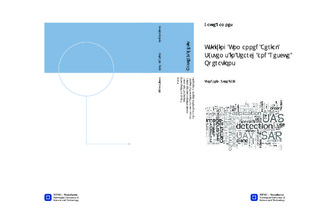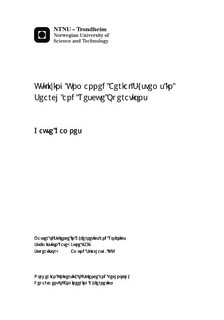| dc.description.abstract | The main objective of this Master Thesis has been to prove the feasibility of utilizing an unmanned aerial system during search and rescue operations, and also to propose and develop a solution for such a system. This concept is proven feasible throughout this report, and a possible system solution for this concept is presented. A prototype system is developed using many already developed devices and the interfaces between these devices are developed. The unmanned aerial system is developed to function with a high degree of autonomy because search and rescue personnel are often occupied with other assignments and do not necessarily have the time to operate such a system. The use of autonomous systems also reduces the need for experienced personnel in order for the system to be utilized; hence making it more likely that the system will be used. The need and desire to use unmanned aerial systems during search and rescue operations has been established through an extensive literature study and this report has been written to help the future development of such a system. Many unmanned aerial systems are in use in today's society for many different applications. However, not many are specifically intended for use during search and rescue operations, and consequently the development of such a specialized system is desired. The advances made in unmanned system technology has recently made such systems more complete, and thus considered for being utilized in more applications than before. A well-known statement is that unmanned system are usually considered for use in operations that are dull, dirty, or dangerous for humans to perform. During search and rescue operations, the search crew often have to cover massive areas in order to locate the missing persons and this work could be tiresome. Having a system that is simple to set up and use, which can do the same search as the SAR crew only faster and more efficiently, will be advantageous for the searchers and thus also the missing persons. In a search and rescue scenario, the more time that goes by, the more dangerous the situation for the missing persons could become, and thus time saved, might mean lives saved. Having a system, which helps save time during search and rescue operations, is therefore much desired.In order to prove the feasibility of the concept of utilizing an unmanned aerial system during search and rescue operations, a literature study was conducted to provide information on other solutions and projects and the result of this study is presented in this report. The report also summarizes how a search and rescue operation could be performed, and this is done in order to provide information that can be used when designing a search and rescue unmanned aerial system. A solution for a system design, and a prototype based on this solution is presented and implemented. The system is also tested and the test results are presented and discussed in the report. The prototype unmanned aerial system includes a commercial autopilot system with its associating components needed for it to function, which is mounted on a plane that is a flying wing. The system also has the option of having a camera detection system mounted on board the plane such that it can detect humans from the air. The detection system was developed such that it can be used on board an unmanned aerial vehicle and consists of a camera and an embedded computer, which can run a detection application. This detection system is also tested and evaluated in this report. The report is written to provide other researchers with a road map to follow during the future development of the concept investigated in this Thesis, and thus getting closer to realizing an operational search and rescue unmanned aerial system.The developed prototype unmanned aerial system of this Master Thesis is a close to functional search and rescue unmanned aerial system. Some parts and some development are missing for the system to be considered operational, but it is possible to further develop it into something usable for search and rescue operations within a reasonable short time. An unmanned aerial vehicle used in previous projects at NTNU was further developed and used as part of the prototype unmanned aerial system developed in this Thesis. A human detection system was also created to be part of the prototype system and some tests of this system are elaborated in the report. The testing of the implemented unmanned aerial system proved the feasibility of developing such a system for use during search and rescue operations, and all system components used performed well.The findings of this report can be used for many other applications as well as search and rescue. The prototype shows that a simple, low cost, easy-to-use unmanned aerial system can be set up to perform quite complex tasks and can thus be used for many applications. An unmanned aerial system is possible to develop for use in search and rescue and the prototype made in this Thesis can be used as a starting point for further development of such systems.This report concludes that the concept of utilizing unmanned aerial system in search and rescue operations is highly feasible and possible to develop. A low cost, easy-to-use, integrated unmanned aerial system can be developed for use during search and rescue operations and could possibly be a valuable tool for the search and rescue personnel. The system could help save time and increase the efficiency of search and rescue operations, and provide an alternative to the manned aircraft used today. The intent of an unmanned aerial system is not to replace any part of today's working search and rescue operations, but rather be a supplement or alternative for the personnel to use if desired. | nb_NO |

